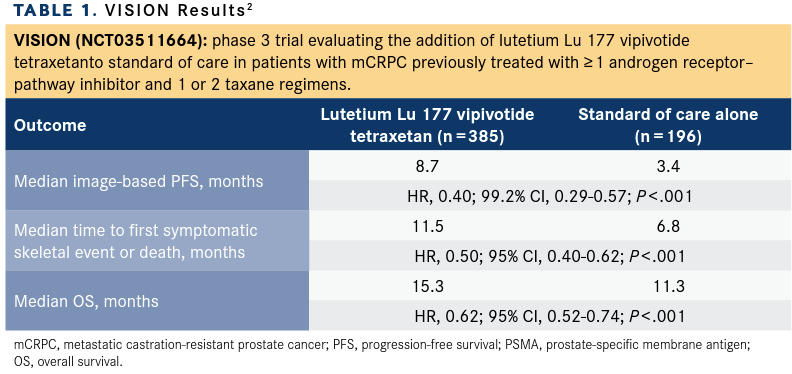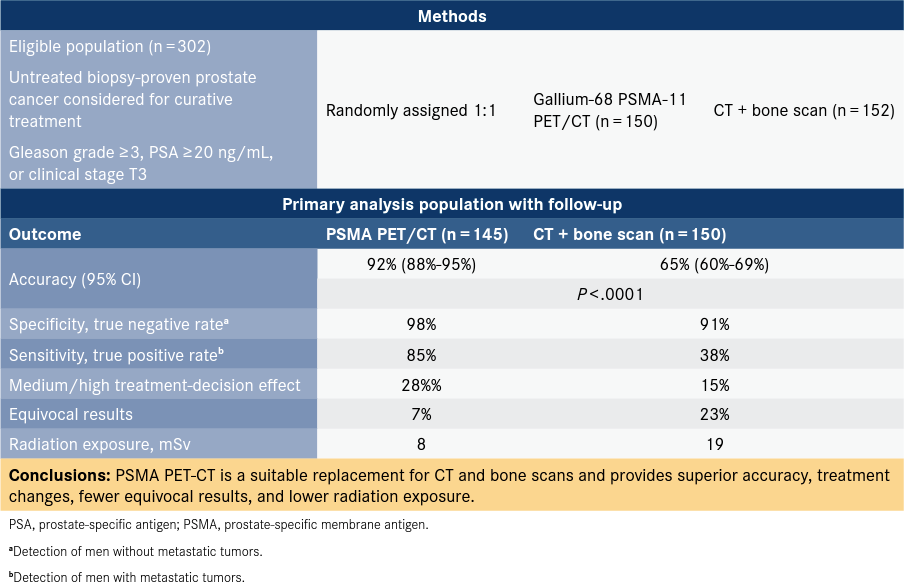Progress in Prostate Cancer Options Creates Excitement
Prostate cancer is the most common cancer in men and the second-leading cause of cancer-related deaths in men in the US.
Mark T. Fleming, MD

Prostate cancer is the most common cancer in men and the second-leading cause of cancer-related deaths in men in the US. Over the past few years, a number of life-prolonging treatment options for patients with advanced prostate cancer have been developed. Unfortunately, many patients eventually experience disease progression and require several lines of subsequent therapy. Durable control with each subsequent treatment is often short.1
However, hope is on the horizon. Promising results have come from the VISION trial (NCT03511664), which evaluated the use of lutetium Lu 177 vipivotide tetraxetan (Pluctivo; formerly 177Lu–PSMA-617) for patients with advanced prostate cancer. Investigators also are utilizing smarter approaches to treatment and research as they recognize that not all prostate cancers are the same.
Recent Trial Results and Approvals Generate Optimism
Results of the phase 3 VISION trial are exciting. VISION investigators evaluated in metastatic castration-resistant prostate cancer (mCRPC) following administration of an androgen receptor–targeting drug and systemic chemotherapy. Risk of death was reduced approximately 40% and a 4-month improvement in median overall survival was observed when lutetium Lu 177 vipivotide tetraxetan was added to standard therapy (TABLE 12).The FDA approved the targeted radioligand for the treatment of patients with prostate-specific membrane antigen (PSMA)–positive mCRPC who have previously been treated with androgen-receptor pathway and taxane-based chemotherapy in March 2022.3 Physicians have been eagerly awaiting the approval of this promising treatment option for patients, which likely will become the new standard of care.
TABLE 1. VISION Results

VISION results also are expected to drive a surge of clinical trials to determine if the same efficacy is found when lutetium Lu 177 vipivotide tetraxetan is employed earlier in the course of the disease. These trials could examine the outcomes of the agent in the prechemotherapy space prior to when an individual becomes symptomatic, as well as in the hormone-sensitive metastatic period clinical space.
Coupling PSMA Diagnostic Targets With Therapeutic Targets
With the FDA approval of lutetium Lu 177 vipivotide tetraxetan, physicians have 2 PSMA-targeted treatment options as well as targeted diagnostic tests. For example, piflufolastat F-18 (Pylarify), a PSMA-targeting PET imaging agent, has been approved by the FDA.4 This cutting-edge nuclear medicine scan for detecting the PSMA protein found on the surface of prostate cancer cells is exceptionally sensitive.
In the proPSMA trial (ANZCTR12617000005358), PSMA PET-CT scans were 92% accurate in detecting metastatic tumors compared with 65% accuracy for CT and bone scans.5 By targeting PSMA, the PET-CT scan provides a clear image and additional information on the location and extent of the cancer, which has broad implications for the diagnosis, management, and ongoing monitoring of the disease (TABLE 25,6). This is a major step forward in the battle against prostate cancer, offering not only more sensitive tests to identify the disease but also the opportunity to pair diagnostic targets with therapeutic targets.
A Smarter Approach is Coming
There is great potential for making significant advances in prostate cancer treatment in the near future. Investigators and physicians are recognizing that not all prostate cancers are the same and that variant histologies and physicians are becoming more mindful of the different features that can affect how patients are treated.
TABLE 2. proPSMA Design and Outcomes

Genomic and molecular testing, as well as next-generation sequencing, are becoming the standard of care used by many physicians, especially those who treat a high volume of patients with prostate cancer. More treatment plans are being developed based on both the molecular and pathological features of the disease. There is evolving evidence that genomic testing can be even more advantageous than traditional guidelines when used for some localized biopsied prostate cancers.
Investigators also are exploring different ways to target DNA repair and immune checkpoint inhibition, and several pathways look very promising. For instance, PTEN, a multifunctional tumor suppressor, is typically lost in many cancers. Approximately 70% of patients with prostate cancer have loss of expression of PTEN.7 PTEN is part of the PI3K/ AKT/mTOR pathway. To date, mTOR inhibitors have not been very successful in treating patients with PTEN loss, and investigators are examining whether microRNAs could be effective.
Multidisciplinary Care Improves Outcomes
Another very positive development for patients with mCRPC is the rapid growth of multidisciplinary team (MDT) care in urologic oncology.8 This care model will become even more important for those with advanced prostate cancer as new treatment options evolve.
Just by the nature of prostate cancer, it is almost a necessity that at least 3 health care providers are involved in patient care: specialists in urology, medical oncology, and radiation oncology. The different perspectives and backgrounds of subspecialty care result in shared decision-making that supports best practices and helps ensure optimal clinical care.
Although multidisciplinary clinics are commonly associated with academic centers, more community-based clinics are building their practices around MDT care. The establishment of MDTs is more complex in the community setting, mainly because of multiple tax IDs. However, community practices, recognizing the many benefits MDT care provides, are striving to offer all critical aspects of outpatient cancer care via tumor boards.
Great Progress Ahead
These are very encouraging times. It is wonderful to see patients do well because there are more treatment options available, largely due to research. Today there are therapies that are very effective with less toxicity, enabling physicians to better manage these cancers than in the past. Progress is even being made in treating patients with oligometastatic sites.
If progress continues to occur in diagnostic testing, there also will be a greater opportunity to catch these cancers earlier and cure more patients—the ultimate goal. There is more hope than ever for patients who not so long ago had few options, and there is strong evidence that continued advancements are right around the corner.
References
- Post-plenary discussion: LBA4, phase III study of lutetium-177-PSMA-617 in patients with metastatic castration-resistant prostate cancer (VISION). Presented at: 2021 American Society of Clinical Oncology Annual Meeting; June, 4-8, 2021; virtual. Accessed February 26, 2022. https://meetinglibrary. asco.org/record/201658/video
- Sartor O, de Bono J, Chi KN, et al; VISION Investigators. Lutetium-177–PSMA-617 for metastatic castration-resistant prostate cancer. N Engl J Med. 2021;385(12):1091-1103. doi:10.1056/ NEJMoa2107322 3. Novartis Pluvicto approved by FDA as first targeted radioligand therapy for treatment of progressive, PSMA positive metastatic castration-resistant prostate cancer. News release.
- Novartis. March 23, 2022. Accessed March 23, 2022. bit.ly/36lu4Ct 4. FDA approves second PSMA-targeted PET imaging drug for men with prostate cancer.
- FDA. Updated May 27, 2021. Accessed March 20, 2022. bit.ly/3IxzKWR
- Winnall W. Benefits of PSMA-PET scans for prostate cancer diagnosis. Prostate Cancer Foundation of Australia. March 31, 2020. Accessed February 24, 2022. bit.ly/36jahn3
- Hofman MS, Lawrentschuk N, Francis RJ, et al; proPSMA Study Group Collaborators. Prostate-specific membrane antigen PET-CT in patients with high-risk prostate cancer before curative-intent surgery or radiotherapy (proPSMA): a prospective, randomised, multicentre study. Lancet. 2020;395(10231):1208-1216. doi:10.1016/S0140-6736(20)30314-7
- PTEN gene - phosphatase and tensin homolog. GeneCards Human Gene Database. Accessed February 24, 2022. bit.ly/3IrMApU
- Holmes A, Kelly BD, Perera M, Eapen RS, Bolton DM, Lawrentschuk N. A systematic scoping review of multidisciplinary cancer team and decision-making in the management of men with advanced prostate cancer. World J Urol. 2021;39(2):297-306. doi:10.1007/s00345-020-03265-1



